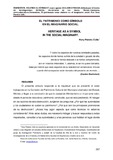El patrimonio como símbolo en el imaginario social

View/
Date
2023-05-18Author
Palabras Clave
Patrimonio, Antropología urbana, Topofilia, Etnografía y patrimonioHeritage, Urban anthropology, Topophilia, Ethnography and heritage
Metadata
Show full item recordAbstract
El presente artículo responde a la inquietud que se presentó al estar trabajando en la
Comisión de Patrimonio Cultural del Municipio Libertador del Estado Mérida, y llegar a
la conclusión de que la ciudad de Mérida tiene un importante valor, desde el punto de
vista de su patrimonio construido, que se está perdiendo. Al indagar en las razones de
esta destrucción, surgieron las preguntas ¿Por qué las autoridades y los ciudadanos no
cuidan su patrimonio? ¿Por qué son los principales promotores de su destrucción?
¿Acaso hay algún aspecto que como técnicos no estamos considerando? Ante estas dudas,
era necesario indagar y buscar respuestas a estas inquietudes, consultar a las
autoridades y a las personas que habitan el lugar donde se concentra la mayor cantidad
de edificaciones con valor patrimonial, bajo la premisa de que es allí, en el centro
fundacional de la ciudad donde se pueden encontrar respuestas. Para ello se realizó
una investigación de carácter etnográfico, con la perspectiva antropológica, que
permitió comprender algunos de los aspectos que desde el punto de vista de la
planificación y gestión de la ciudad no había sido considerado: los sentimientos y el
arraigo.
Collections
Información Adicional
| Correo Electrónico | norypc@ula.ve |
| Editor | SaberULA |
| ISSN | 0798-3069 |
| Resumen en otro Idioma | This article responds to the concern that was presented when working in the Cultural Heritage Commission of the Libertador Municipality of Mérida State, and reaching the conclusion that the city of Mérida has an important value, from the point of view of its built heritage, which is being lost. When inquiring into the reasons for this destruction, the questions arose: Why do the authorities and citizens not take care of their heritage? Why are they the main promoters of its destruction? Is there an aspect that we as technicians are not considering? Given these doubts, it was necessary to investigate and seek answers to these concerns, consult the authorities and the people who inhabit the place where the largest number of buildings with heritage value is concentrated, under the premise that it is there, in the founding center of the city where answers can be found. To this end, an ethnographic research was carried out, with the anthropological perspective, which allowed us to understand some of the aspects that from the point of view of the planning and management of the city had not been considered: feelings and rootedness. |
| Colación | 297-331 |
| Periodicidad | Cuatrimestral |
| Página Web | www.saber.ula.ve/fermentum |
| País | Venezuela |
| Institución | Universidad de Los Andes |
| Sección | Fermentum: Dossier No. 2 |





